2022年英语中考语法复习课件---形容词和副词的用法(27张)
文档属性
| 名称 | 2022年英语中考语法复习课件---形容词和副词的用法(27张) |  | |
| 格式 | pptx | ||
| 文件大小 | 23.6MB | ||
| 资源类型 | 教案 | ||
| 版本资源 | 通用版 | ||
| 科目 | 英语 | ||
| 更新时间 | 2022-05-09 20:21:17 | ||
图片预览

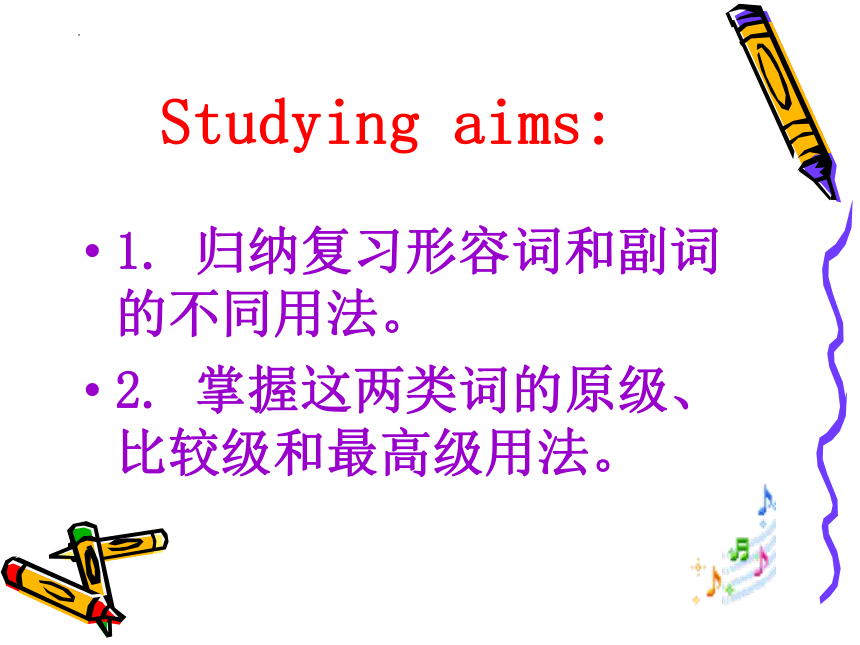
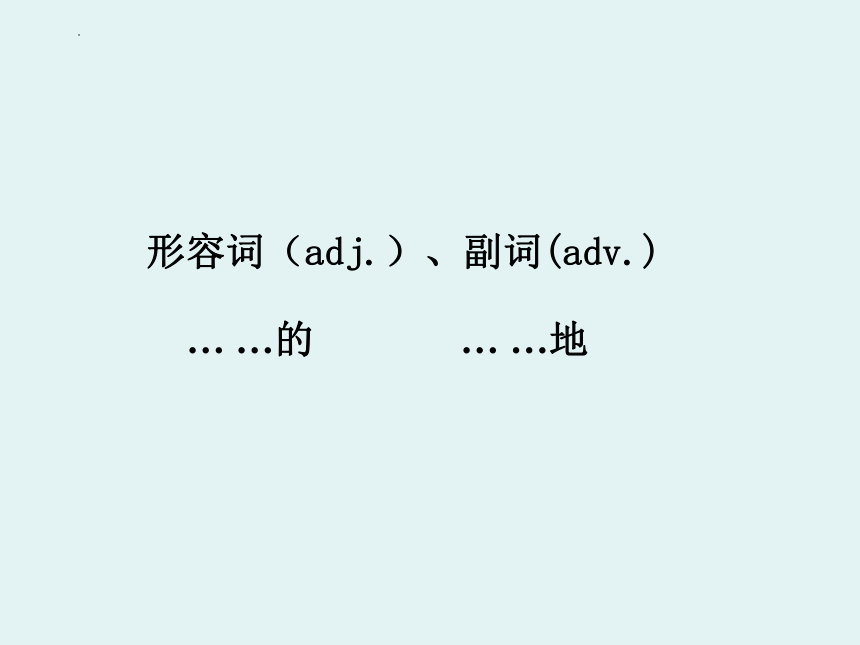
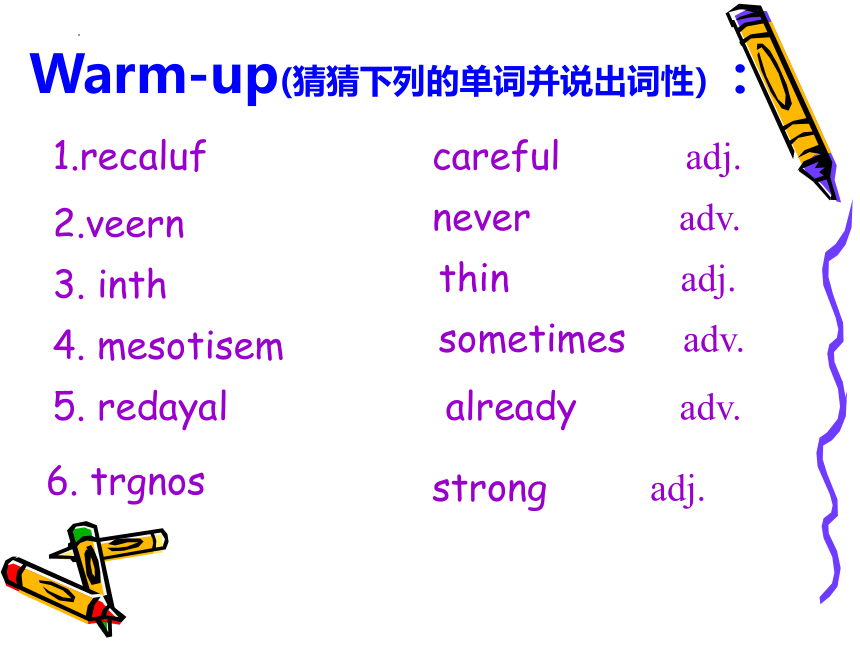
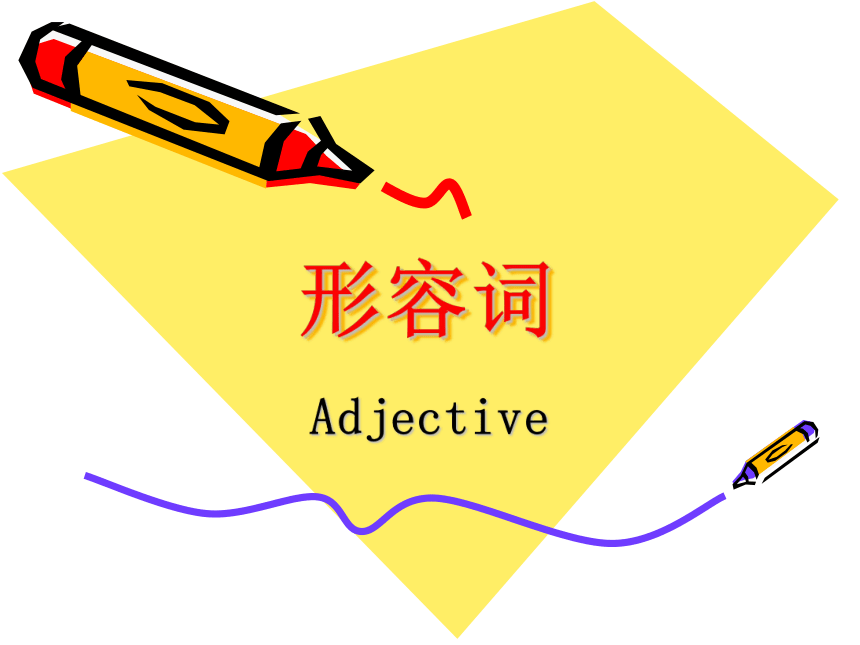
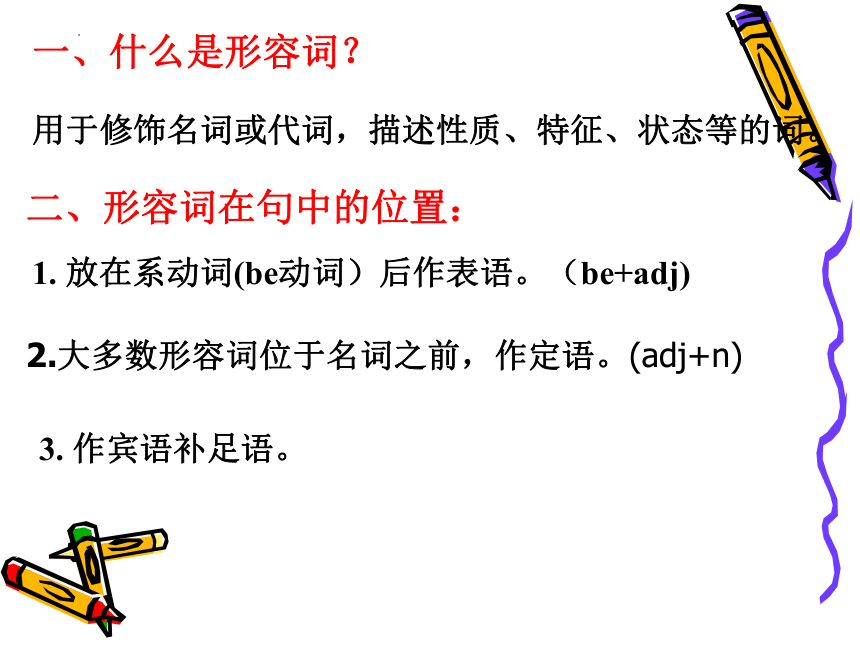
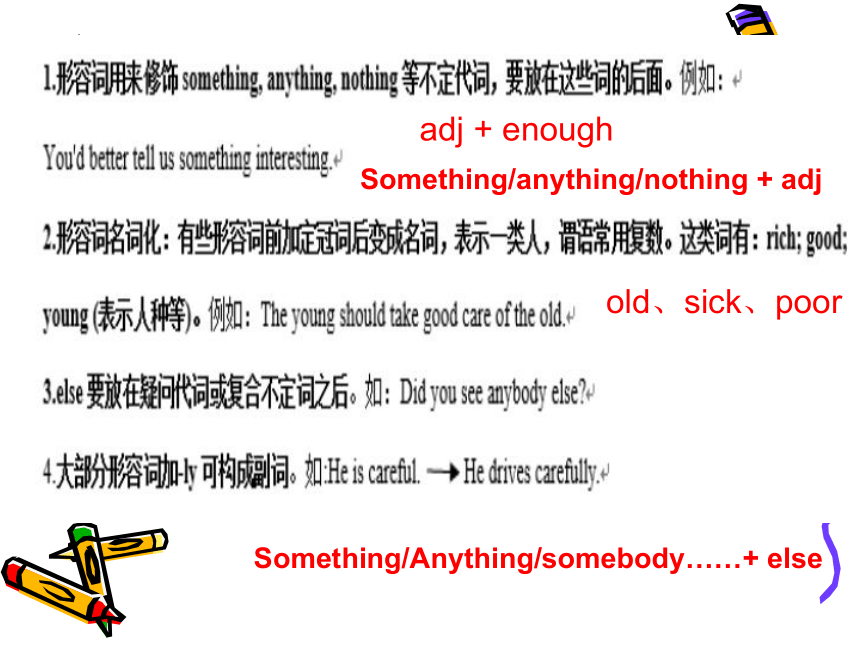
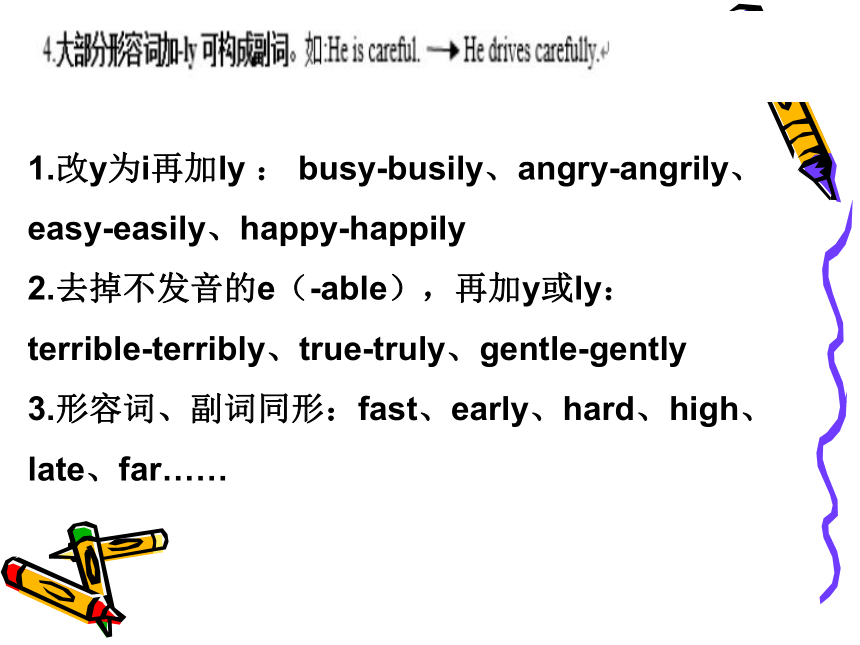
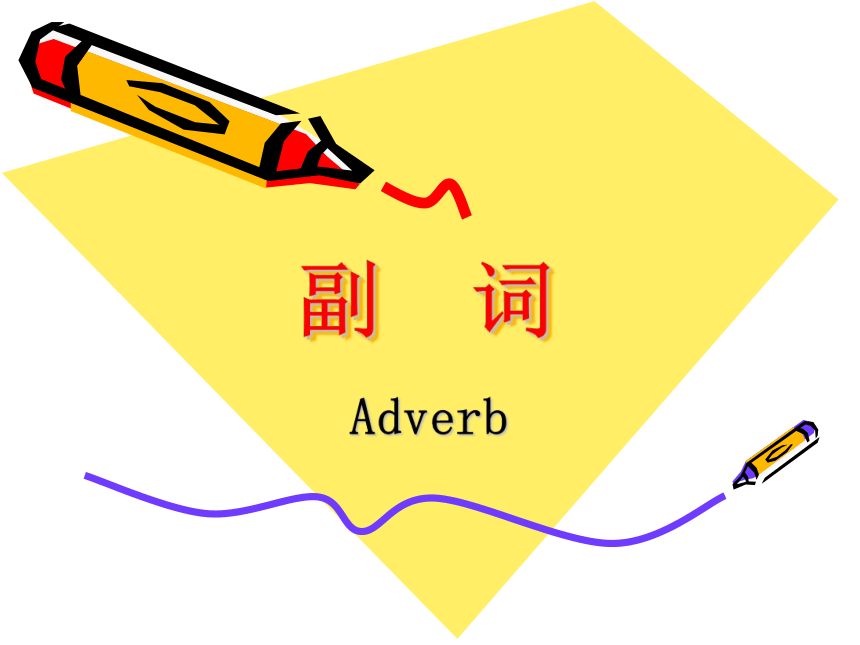
文档简介
(共27张PPT)
形容词和副词
专项复习
Studying aims:
1. 归纳复习形容词和副词的不同用法。
2. 掌握这两类词的原级、比较级和最高级用法。
形容词(adj.)、副词(adv.)
… …的
… …地
Warm-up(猜猜下列的单词并说出词性):
1.recaluf
2.veern
3. inth
4. mesotisem
5. redayal
6. trgnos
careful adj.
never adv.
thin adj.
sometimes adv.
already adv.
strong adj.
形容词
Adjective
2.大多数形容词位于名词之前,作定语。(adj+n)
一、什么是形容词?
1. 放在系动词(be动词)后作表语。(be+adj)
3. 作宾语补足语。
二、形容词在句中的位置:
用于修饰名词或代词,描述性质、特征、状态等的词。
Something/anything/nothing + adj
adj + enough
old、sick、poor
Something/Anything/somebody……+ else
1.改y为i再加ly : busy-busily、angry-angrily、easy-easily、happy-happily
2.去掉不发音的e(-able),再加y或ly: terrible-terribly、true-truly、gentle-gently
3.形容词、副词同形:fast、early、hard、high、late、far……
副 词
Adverb
一、什么是副词?
Jim runs quickly. (修饰动词run)
副词:主要用于修饰动词、形容词和副词的词,也可以修饰整句。
She is very beautiful. (修饰形容词beautiful)
Jim plays basketball very well. (修饰副词well)
二、副词在句子中的位置:
Jim runs quickly. (一般用于动词之后或句末)
She is very beautiful. (修饰形容词之前)
Jim plays basketball very well. (修饰副词之前)
副词的位置 多数副词都可以放在它所修饰的动词后面。
如:He runs slowly.
时间副词、地点副词和方式副词一般放在句末。
如:They went to the park yesterday morning. I heard him sing English songs over there.
adv + v
也就是时间状语、地点状语
eg.yesterday、tomorrow、now,here、outside、
at home……
频度副词一般放在 be 动词、情态动词及第一个助动词之后,实义动词之前。
如: He is seldom ill. You must always remember this. I often write to my parents.
程度副词修饰动词时,与频度副词相同,修饰形容词和副词时,放在它所修饰的词前面。
如:I nearly missed the bus.
频度副词:always、usually、often、sometimes、seldom、never
否定副词一般放在动词之前、系动词 be 或助动词之后。
如:She seldom goes out at night. I am never late for school
否定副词:hardly(几乎不)、little(几乎没有)、few(几乎没有)、rarely(很少)
疑问副词放在特殊疑问句的句首。
如:When can you come 还有 what,how,why,how many 等词。同时存在时间状语和地点状语时,时间状语一般放在后面。
如:The meeting will be held in the classroom tomorrow.
形容词和副词的
原级、比较级和最高级
比较级、最高级的变化规则
一般
加er或est
tall –taller--tallest
small—smaller--smallest
二般
以不发音的e结尾的,加r或st
large –larger--largest
wide—wider--widest
比较级、最高级的变化规则
三般
以辅音字母+y结尾,变y为i,加er或est
heavy easy lazy hungry busy thirsty
四般
以重读辅元辅结尾,双写尾字母,加er或est
big hot sad fat thin
比较级、最高级的变化规则
五般
多音节加more或the most
beautiful interesting difficult delicious intelligent famous dangerous important careful
特
good—better—the best
bad--- worse—the worst
many/much—more—the most
多音节:单词中有三个或三个以上的元音字母
笔记 不规则变化
原形 good bad little many/much
比较级 ________ worse less
__________
最高级 best _______ _______
_______
far (远,原形)
-- further(更远,比较级)—furthest(最远,最高级)程度深
far (远,原形)
-- farther(更远,比较级)—farthest(最远,最高级)距离远
better
worst
least
more
most
二、原级的常用句型
Xiong Da is as tall/fat as Xiong Er.
as...as 和...一样
二、原级的常用句型
Liu Xiang is not as/so tall as Yao Ming.
not as/so...as 不如....
Yao Ming is taller than Liu Xiang.
Liu Xiang is shorter than Yao Ming.
二、原级的常用句型
倍数+as...as
The pink ruler is twice as long as the blue one.
1、比较级+than…
三、比较级的常用句型
2、Which is+ 比较级,…or…
3、不及另一方时,使用“less+原级+than…”
4、the +比较级+of the two
5、修饰形容词比较级的词有:much、a little、 a bit、 a lot 、even、 far 等。
6、The+比较级…,the+比较级…
7、…比较级+and+比较级…
8、数量词+比较级+than
笔记
2、…one of the+形容词最高级+名词复数
四、最高级的常用句型
1、…最高级+of (in)…
Lu Xun is one of the greatest writers.
He is the tallest boy of all.
笔记
四、最高级的常用句型
3、the+序数词+最高级+单数名词
Yellow River is the second longest river in China.
4、This is/ was the最高级+名词+that…
This is the worst film that I have seen these years.
形容词
1.形容词作后置定语
2.The +形容词,名词化
3.形容词变副词的规律
1.直接加ly
2.改Y为i加ly
3.去e加ly
4.不变
副词
1.一般副词
2.时间、地点副词
3.频度副词
4.程度副词
5.否定副词
6.疑问副词
比较级、最高级的变化规律
形容词和副词
专项复习
Studying aims:
1. 归纳复习形容词和副词的不同用法。
2. 掌握这两类词的原级、比较级和最高级用法。
形容词(adj.)、副词(adv.)
… …的
… …地
Warm-up(猜猜下列的单词并说出词性):
1.recaluf
2.veern
3. inth
4. mesotisem
5. redayal
6. trgnos
careful adj.
never adv.
thin adj.
sometimes adv.
already adv.
strong adj.
形容词
Adjective
2.大多数形容词位于名词之前,作定语。(adj+n)
一、什么是形容词?
1. 放在系动词(be动词)后作表语。(be+adj)
3. 作宾语补足语。
二、形容词在句中的位置:
用于修饰名词或代词,描述性质、特征、状态等的词。
Something/anything/nothing + adj
adj + enough
old、sick、poor
Something/Anything/somebody……+ else
1.改y为i再加ly : busy-busily、angry-angrily、easy-easily、happy-happily
2.去掉不发音的e(-able),再加y或ly: terrible-terribly、true-truly、gentle-gently
3.形容词、副词同形:fast、early、hard、high、late、far……
副 词
Adverb
一、什么是副词?
Jim runs quickly. (修饰动词run)
副词:主要用于修饰动词、形容词和副词的词,也可以修饰整句。
She is very beautiful. (修饰形容词beautiful)
Jim plays basketball very well. (修饰副词well)
二、副词在句子中的位置:
Jim runs quickly. (一般用于动词之后或句末)
She is very beautiful. (修饰形容词之前)
Jim plays basketball very well. (修饰副词之前)
副词的位置 多数副词都可以放在它所修饰的动词后面。
如:He runs slowly.
时间副词、地点副词和方式副词一般放在句末。
如:They went to the park yesterday morning. I heard him sing English songs over there.
adv + v
也就是时间状语、地点状语
eg.yesterday、tomorrow、now,here、outside、
at home……
频度副词一般放在 be 动词、情态动词及第一个助动词之后,实义动词之前。
如: He is seldom ill. You must always remember this. I often write to my parents.
程度副词修饰动词时,与频度副词相同,修饰形容词和副词时,放在它所修饰的词前面。
如:I nearly missed the bus.
频度副词:always、usually、often、sometimes、seldom、never
否定副词一般放在动词之前、系动词 be 或助动词之后。
如:She seldom goes out at night. I am never late for school
否定副词:hardly(几乎不)、little(几乎没有)、few(几乎没有)、rarely(很少)
疑问副词放在特殊疑问句的句首。
如:When can you come 还有 what,how,why,how many 等词。同时存在时间状语和地点状语时,时间状语一般放在后面。
如:The meeting will be held in the classroom tomorrow.
形容词和副词的
原级、比较级和最高级
比较级、最高级的变化规则
一般
加er或est
tall –taller--tallest
small—smaller--smallest
二般
以不发音的e结尾的,加r或st
large –larger--largest
wide—wider--widest
比较级、最高级的变化规则
三般
以辅音字母+y结尾,变y为i,加er或est
heavy easy lazy hungry busy thirsty
四般
以重读辅元辅结尾,双写尾字母,加er或est
big hot sad fat thin
比较级、最高级的变化规则
五般
多音节加more或the most
beautiful interesting difficult delicious intelligent famous dangerous important careful
特
good—better—the best
bad--- worse—the worst
many/much—more—the most
多音节:单词中有三个或三个以上的元音字母
笔记 不规则变化
原形 good bad little many/much
比较级 ________ worse less
__________
最高级 best _______ _______
_______
far (远,原形)
-- further(更远,比较级)—furthest(最远,最高级)程度深
far (远,原形)
-- farther(更远,比较级)—farthest(最远,最高级)距离远
better
worst
least
more
most
二、原级的常用句型
Xiong Da is as tall/fat as Xiong Er.
as...as 和...一样
二、原级的常用句型
Liu Xiang is not as/so tall as Yao Ming.
not as/so...as 不如....
Yao Ming is taller than Liu Xiang.
Liu Xiang is shorter than Yao Ming.
二、原级的常用句型
倍数+as...as
The pink ruler is twice as long as the blue one.
1、比较级+than…
三、比较级的常用句型
2、Which is+ 比较级,…or…
3、不及另一方时,使用“less+原级+than…”
4、the +比较级+of the two
5、修饰形容词比较级的词有:much、a little、 a bit、 a lot 、even、 far 等。
6、The+比较级…,the+比较级…
7、…比较级+and+比较级…
8、数量词+比较级+than
笔记
2、…one of the+形容词最高级+名词复数
四、最高级的常用句型
1、…最高级+of (in)…
Lu Xun is one of the greatest writers.
He is the tallest boy of all.
笔记
四、最高级的常用句型
3、the+序数词+最高级+单数名词
Yellow River is the second longest river in China.
4、This is/ was the最高级+名词+that…
This is the worst film that I have seen these years.
形容词
1.形容词作后置定语
2.The +形容词,名词化
3.形容词变副词的规律
1.直接加ly
2.改Y为i加ly
3.去e加ly
4.不变
副词
1.一般副词
2.时间、地点副词
3.频度副词
4.程度副词
5.否定副词
6.疑问副词
比较级、最高级的变化规律
同课章节目录
- 词法
- 名词
- 动词和动词短语
- 动词语态
- 动词时态
- 助动词和情态动词
- 非谓语动词
- 冠词
- 代词
- 数词和量词
- 形容词副词及其比较等级
- 介词和介词短语
- 连词和感叹词
- 构词法
- 相似、相近词比较
- 句法
- 陈述句
- 一般疑问句和否定疑问句
- 特殊疑问句及选择疑问句
- 反意疑问句
- 存在句(There be句型)
- 宾语从句
- 定语从句
- 状语从句
- 主谓一致问题
- 简单句
- 并列句
- 复合句
- 主谓一致
- 主、表语从句
- 名词性从句
- 直接引语和间接引语
- 虚拟语气
- 感叹句
- 强调句
- 倒装句
- 祈使句
- 句子的成分
- 句子的分类
- 题型专区
- 单项选择部分
- 易错题
- 完形填空
- 阅读理解
- 词汇练习
- 听说训练
- 句型转换
- 补全对话
- 短文改错
- 翻译
- 书面表达
- 任务型阅读
- 语法填空
- 其他资料
